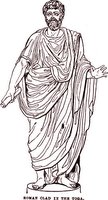Saturday, March 18, 2006
What's in a Toga?

Well, a lot of material, to start with. Do you know why there are so many drapes and folds in a toga (yes, that white "sheet" that Romans used to losely wrap themselves with)?
A toga had no less than 18-20 feet in length! And Romans had a special way of wrapping it around them so that it enclosed the left side and arm, and left the right arm free. Roman men used the toga when they went to parade outside the home, and it was worn over a tunic, their homewear.

The toga was made from wool, and the tunic, linen. I wonder how rough that wool was? I had always imagined the toga as being made from another lighter material, since we can see so many small folds in the Roman statues. Surely, it couldn't have been a very thick wool, because thick wool doesn't ply into multiple folds like that.
Look at those partially covered legs!! too funny!
The toga of an ordinary citizen, like his tunic, was the natural color of the wool from which it was made, and varied in texture according to the quality of the wool. It was called toga pura (plain toga), or toga virilis (man's toga), or toga libera (free toga). A dazzling brilliance could be given to a garment with a preparation of fuller's chalk, and one so treated was called toga candida (white toga). All men running for office all wore this toga. Hence, office seekers today are called candidates. [another cool etymology bit! :-) ]
Curule (high-ranking) magistrates, censors, and dictators wore the toga praetexta, with a border of purple. It was also worn by boys and by the chief officials of free towns and colonies. The border was woven or sewed on the curved edge.
The toga picta (crimson, embroidered in gold), was worn in triumphal processions by victorious generals, and later by emperors. [you have seen this in movies :-) ]
And in case you are wondering, they didn't go nakkid underneath their togas and tunics, Romans who were part of the senate wore purple heart boxer shorts underneath! (LOL ;-) Actually, they wore a loincloth.
Styles of Hair and Beards
In early times Romans wore long hair and full beards. According to Varro, professional barbers first came to Rome in 300 BC, but razors and shears were used before the beginning of history. Citizens of wealth and position had their hair and beards kept in order by their own slaves. Slaves who were skillful barbers brought good prices. Men of the middle class went to public barbershops, which became gathering places for idlers and gossips. The very poor found it cheap and easy to go unshaven. But in all periods, hair and beard were allowed to grow as a sign of sorrow as much a part of mourning as mourning clothes.
Different styles of hair and beard varied with the age of the man and the period. The hairs of children (boys and girls) were allowed to grow their hair long and hang around the neck and shoulders. When a boy became a man, he had to cut off his locks; sometimes with great formality. During the Empire they were often made an offering to some god. In classical times, young men wore close-clipped beards. Mature men were clean-shaven and wore their hair short. Most statues that have survived show beardless men until well into the 2nd century of our era. But when Emperor Hadrian (AD 117-138) wore a beard, full beards became fashionable.
Comments:
Post a Comment
